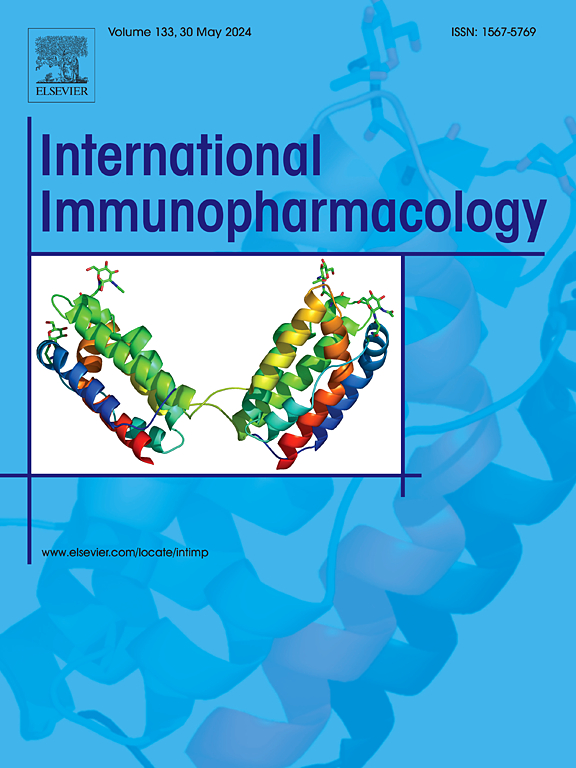TAK-242通过TLR4/NF-κB途径减轻实验性自身免疫性神经炎大鼠nlrp53 - asc炎性小体介导的神经炎症
IF 4.7
2区 医学
Q2 IMMUNOLOGY
引用次数: 0
摘要
TLR4受体的抑制已被证明可以保护周围神经系统(PNS)疾病的神经结构和改善神经功能。尽管炎症小体是影响中枢神经系统(CNS)的免疫性疾病的病理生理学的重要组成部分,但关于炎症小体在免疫相关PNS疾病(如格林-巴罗综合征(GBS))中神经炎症过程中的作用的研究却很少。本研究发现,在实验性自身免疫性神经炎(EAN)的坐骨神经中,TLR4的表达以及NLRP3炎性体的形成和激活增加。进一步腹腔注射选择性TLR4受体抑制剂TAK-242 (Resatorvid)表明,TAK-242不仅在一定程度上阻止了EAN的进展,而且还减轻了EAN引起的周围神经损伤,表现为体重减轻、神经功能评分和神经传导缺陷的改善。更重要的是,TAK-242主要通过抑制TLR4/NF-κB信号通路和降低NLRP3炎性体激活,有效抑制EAN大鼠神经炎症,减轻髓磷脂损失,促进EAN周围神经损伤的再生和修复。基于这些发现,给药TAK-242可作为GBS的潜在治疗方法。本文章由计算机程序翻译,如有差异,请以英文原文为准。
TAK-242 attenuates NLRP3-ASC inflammasome-mediated neuroinflammation via TLR4/NF-κB pathway in rat experimental autoimmune neuritis
The inhibition of the TLR4 receptor has been shown to protect neural structure and improve neurological functions in peripheral nervous system (PNS) diseases. There is a scarcity of research regarding the effect of inflammasomes during the process of neuroinflammation in immune related PNS disorders, such as, Guillain-Barré syndrome (GBS), even though it is an essential part for pathophysiology from immunological diseases that impact central nervous system (CNS). In this investigation, we found that TLR4 expression and formation and activation of the NLRP3 inflammasome were increased in the sciatic nerve of experimental autoimmune neuritis (EAN). Further intraperitoneal injection of the selective TLR4 receptor inhibitor TAK-242 (Resatorvid) showed that TAK-242 not only stopped the advancement of EAN to a certain extent, but also alleviated peripheral nerve injury brought on by EAN, as evidenced by improvements in body weight loss, neurological function scores, and nerve conduction deficits. More importantly, TAK-242 effectively inhibited neuroinflammation in EAN rats, mitigated myelin loss and helped the regeneration and repair of EAN peripheral nerve injury, mainly through suppressing TLR4/NF-κB signaling pathway and decreasing NLRP3 inflammasome activation. Based on these findings, administration of TAK-242 can be used as a potential therapy approach for GBS.
求助全文
通过发布文献求助,成功后即可免费获取论文全文。
去求助
来源期刊
CiteScore
8.40
自引率
3.60%
发文量
935
审稿时长
53 days
期刊介绍:
International Immunopharmacology is the primary vehicle for the publication of original research papers pertinent to the overlapping areas of immunology, pharmacology, cytokine biology, immunotherapy, immunopathology and immunotoxicology. Review articles that encompass these subjects are also welcome.
The subject material appropriate for submission includes:
• Clinical studies employing immunotherapy of any type including the use of: bacterial and chemical agents; thymic hormones, interferon, lymphokines, etc., in transplantation and diseases such as cancer, immunodeficiency, chronic infection and allergic, inflammatory or autoimmune disorders.
• Studies on the mechanisms of action of these agents for specific parameters of immune competence as well as the overall clinical state.
• Pre-clinical animal studies and in vitro studies on mechanisms of action with immunopotentiators, immunomodulators, immunoadjuvants and other pharmacological agents active on cells participating in immune or allergic responses.
• Pharmacological compounds, microbial products and toxicological agents that affect the lymphoid system, and their mechanisms of action.
• Agents that activate genes or modify transcription and translation within the immune response.
• Substances activated, generated, or released through immunologic or related pathways that are pharmacologically active.
• Production, function and regulation of cytokines and their receptors.
• Classical pharmacological studies on the effects of chemokines and bioactive factors released during immunological reactions.

 求助内容:
求助内容: 应助结果提醒方式:
应助结果提醒方式:


